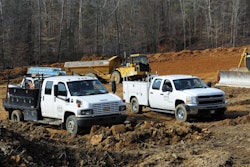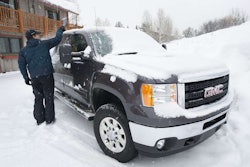Inside Fluid Dampers: Industrial Grade Diesel Engine Protection
When crankshaft dampers wear out, the increased vibrations accelerate wear on critical parts such as main bearings and timing components; upgrade can solve problems and add torque
By Brian LeBarron
 Viscous dampers feature a free rotating inertia ring
Viscous dampers feature a free rotating inertia ringenclosed in a housing. The inertia ring combats torsional
vibration frequencies across the entire rpm range by
constantly shearing through a layer of viscous fluid. This
converts the energy into heat which rapidly dissipates through
the housing. The benefit is enhanced engine protection,
performance and durability.
In today’s economy, keeping your work truck operating at optimum efficiency over the long haul translates right to the bottom line.
One of the most important overlooked parts on professional light duty diesel truck engines is the crankshaft damper.
While it may seem disguised as the main drive pulley, its true purpose is to prolong crankshaft life and reduce wear of critical internal components by reducing harmful torsional vibration caused by combustion.
As combustion forces continue to increase in modern diesel engines, so does the need to protect it for reliability and durability.
The majority of light duty diesel trucks continue to come stock with an elastomer base crankshaft damper. This cost-effective approach uses a tuned rubber strip bonded between a hub and outer inertia ring.
VIBRATION FIGHTERS
When a predetermined peak vibration resonates the rubber strip, it throws the inertia ring to counteract the twisting/rebounding of the crankshaft. Uncontrolled torsional vibration can accelerate the wear of main bearings, timing components and even break the crankshaft.
Performance upgrades, heavy towing/hauling, age and weather may all have adverse effects on an elastomer damper.
Performance parts that increase torque, such as air kits, exhaust, injectors and tuners and/or continuously operating in peak powerbands during towing and hauling, may cause the damper to overwork itself.
As the damper works harder, heat generated becomes trapped longer in the rubber material and causes it to dry crack or heat bulge. As the rubber in the damper breaks down its ability to protect the engine diminishes with the real possibility of catastrophic failure.
(A simple preventative maintenance tip is to routinely inspect an elastomer damper for cracked, bulging or missing rubber. Some vehicle manufacturers even recommend this in their Owner’s Manuals.
A more severe and unnoticeable shortcoming is when rotating assembly parts such as the pistons, rods, flywheel/flextpate or crankshaft are changed. This will cause a change in the assembly’s resonate frequency and may negate the effectiveness of the damper during peak torsional vibration altogether.
THE VISCOUS DAMPER
From over-the-road trucks to heavy construction equipment and agriculture, the majority of dependable high-power diesel engines that move our economy rely on a viscous damper.
Viscous dampers are the premium choice over an elastomer style because they feature broad band frequency protection, rapid heat dissipation and can become more effective as torque increases to provide continuous long lasting engine protection, performance and durability.
Viscous damper technology uses a free-rotating inertia ring inside a sealed outer housing.Between the two, an area referred to as the shear gap, is a heavy viscous fluid.
 Signs of cracked, bulging or missing rubber are early signs that your stock elastomer crankshaft damper may not be adequately protecting your engine from destructive torsional vibrations.
Signs of cracked, bulging or missing rubber are early signs that your stock elastomer crankshaft damper may not be adequately protecting your engine from destructive torsional vibrations.
The outer housing rotates at engine rpm, while the inner ring absorbs varying frequencies of vibration throughout the rpm range.
As the inner ring constantly attempts to catch up to engine rpm the shearing action through the fluid transforms the vibration into heat which rapidly dissipates through the housing.
Professional diesel motorsports teams have long upgraded from the stock elastomer damper to a viscous damper.
Fluidampr, the official damper of DIESEL Motorsports, is a competition quality viscous damper engineered for popular light duty diesel trucks, including all late-model Power Stroke, Duramax and Cummins engines.
Fluidampr Performance Diesel dampers are made in the USA and feature precision CNC-machined and computer-balanced components, a laser-welded cover and are finished in a corrosion protective black zinc chromate.
The fluid within the shear gap is a premium silicone approx. 45,000 times thicker than 30w oil. Silicone provides thermal stability across extreme temperature ranges, high shear strength and excellent heat dissipation.
While you may not be putting your work truck through the paces of professional diesel drag racing or sled pulling, your heavy-duty pickup’s engine can still benefit from the added protection, performance and durability of upgrading to a viscous damper, particularly if power modifications have been made.
Even under stock conditions, many daily diesel truck drivers report smoother idle, less in-cab vibration and reduced drive line noise when upgrading to Fluidampr.
Next time you’re under the hood of your work truck, check your stock damper. Fluidampr Performance Diesel dampers are available through many quality truck parts and accessories distributors. 
ENGINE VIBRATIONS
- Torsional Vibration: End-to-end twisting and rebounding motion of the crankshaft generated from each combustion event. Its effects are controlled by the crankshaft damper, or harmonic balancer.
- Resonate Frequency: Every object has a frequency at which it too will vibrate. When torsional vibrations begin to align with the resonate point of the crankshaft, magnitude is amplified and the result can be a broken crank. The concept is the same as a glass shattering from a high pitch note.
- Rotational Vibration: Rotational vibration occurs when reciprocating weights between the piston/rod and crankshaft are not matched. Correcting or fine-tuning this is referred to as engine balancing. To accommodate for room inside the engine block, some OEMs (Power Stroke and Duramax) incorporate a counterweight on the crankshaft damper. Just because an engine is balanced, does not eliminate the need for a crankshaft damper.
 Dyno results and performance gains for Cummins with Fluidampr installed.
Dyno results and performance gains for Cummins with Fluidampr installed.


About the Author
Brian LeBarron is a marketing representative at Vibratech TVD, a global leader in the development and manufacturing of viscous dampers from 5” to 56” for powertrain OEMs. Located in Springville, New York, Vibratech TVD is an ISO 9001:2008 design and development certified and quality systems certified company. Fluidampr is a performance product of Vibratech TVD.








